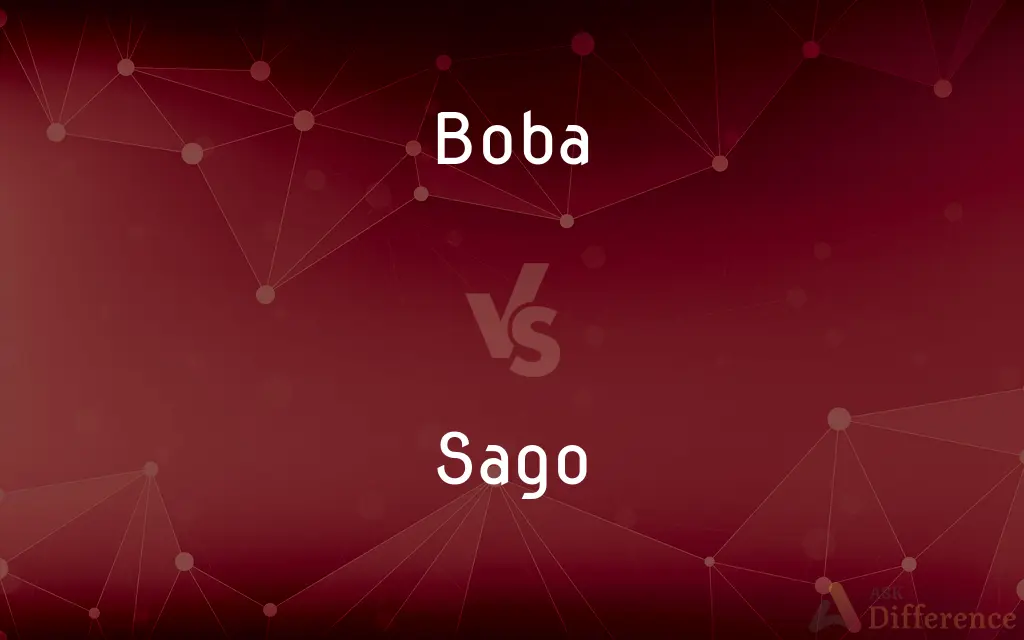Boba vs. Sago — What's the Difference?
By Fiza Rafique & Urooj Arif — Updated on April 22, 2024
Boba are chewy tapioca pearls used in beverages, made from cassava root, while sago is a starch extracted from tropical palms used in various dishes.

Difference Between Boba and Sago
Table of Contents
ADVERTISEMENT
Key Differences
Boba is a term popularly used to refer to tapioca pearls, primarily made from cassava starch, featured in bubble tea and known for their chewy texture. Sago, on the other hand, refers to starch extracted from the pith of various tropical palm stems and is widely used in puddings and traditional dishes.
Boba pearls are typically larger and have a gummy bear-like consistency, ideal for sucking up through a large straw, whereas sago pearls are smaller and often used as a thickening agent in cooking.
In culinary uses, boba is almost exclusively found in sweet tea-based beverages, while sago is versatile, featuring in both savory and sweet dishes.
Nutritionally, both boba and sago are high in carbohydrates and low in fat, but boba often has added sugars, making it higher in calories.
Comparison Chart
Source
Made from cassava root starch.
Made from starch extracted from tropical palm stems.
ADVERTISEMENT
Texture
Chewy, gummy bear-like texture.
Small, granular, more delicate texture.
Primary Use
Primarily used in bubble tea and sweet beverages.
Used in puddings, soups, and both sweet and savory dishes.
Size
Generally larger pearls.
Smaller, more uniform pearls.
Nutritional Content
High in carbs, often sweetened.
High in carbs, usually not sweetened.
Compare with Definitions
Boba
Requires boiling for preparation.
He boiled the boba until they were perfectly soft.
Sago
Starch extracted from palm stems, used in various dishes.
She used sago to thicken her stew.
Boba
Chewy pearls made from tapioca starch, popular in bubble tea.
She ordered a green tea with boba at the cafe.
Sago
Found in both sweet and savory recipes.
Sago is versatile, appearing in both the dessert and the main dish.
Boba
Often sweetened with syrup after cooking.
The boba was soaked in honey syrup to enhance its sweetness.
Sago
Cooked until translucent and soft.
The sago was cooked until it turned clear and had a jelly-like texture.
Boba
Comes in various sizes and sometimes colors.
The menu featured both black and clear boba options.
Sago
Used as a thickening agent in some traditional dishes.
He thickened the sauce using sago instead of cornstarch.
Boba
Primarily an addition to cold beverages.
Her favorite summer drink is iced coffee with boba.
Sago
Forms small, pearl-like particles when processed.
Sago pearls were added to the pudding for texture.
Boba
Syn of tapioca pearl.
Sago
Sago () is a starch extracted from the spongy centre, or pith, of various tropical palm stems, especially those of Metroxylon sagu. It is a major staple food for the lowland peoples of New Guinea and the Moluccas, where it is called saksak, rabia and sagu.
Sago
A powdery starch obtained from the pith of certain palm trees and cycads, used as a staple food chiefly in Asia and as a food thickener.
Sago
A powdered starch obtained from certain palms and used as a food thickener.
Sago
A similar starch obtained from a palm-like cycad (Cycas revoluta)
Sago
Any of the palms from which sago is extracted.
Sago
A dry granulated starch imported from the East Indies, much used for making puddings and as an article of diet for the sick; also, as starch, for stiffening textile fabrics. It is prepared from the stems of several East Indian and Malayan palm trees, but chiefly from the Metroxylon Sagu; also from several cycadaceous plants (Cycas revoluta, Zamia integrifolia, etc.).
Sago
Powdery starch from certain sago palms; used in Asia as a food thickener and textile stiffener
Common Curiosities
Can boba and sago be used interchangeably?
No, because their textures and typical uses differ significantly.
What is boba made from?
Boba is made from tapioca starch derived from cassava roots.
Are boba and sago gluten-free?
Yes, both are gluten-free as they are made from starch.
What is sago used for?
Sago is used in various culinary applications, from desserts to soups.
What dishes are boba commonly found in?
Boba is almost exclusively used in sweet beverages like bubble tea.
Can sago be used in beverages?
Yes, but it is more commonly used in puddings and other dishes.
Is boba available in different colors?
Yes, boba can be found in a variety of colors, which are often added during processing.
How are boba pearls prepared?
Boba pearls are boiled until they become soft and chewy.
What texture does sago have?
Sago pearls are soft and jelly-like when cooked.
How does the nutritional content of boba and sago compare?
Both are high in carbohydrates, but boba often contains more calories due to added sugars.
Which is healthier, boba or sago?
Sago tends to be healthier as it is usually not sweetened, unlike boba which often contains added sugar.
What is the origin of sago?
Sago is derived from several Southeast Asian palm species.
Are boba pearls always sweet?
They are typically sweetened, but the level of sweetness can vary.
Share Your Discovery

Previous Comparison
Tissue vs. Napkin
Next Comparison
Company vs. FriendAuthor Spotlight
Written by
Fiza RafiqueFiza Rafique is a skilled content writer at AskDifference.com, where she meticulously refines and enhances written pieces. Drawing from her vast editorial expertise, Fiza ensures clarity, accuracy, and precision in every article. Passionate about language, she continually seeks to elevate the quality of content for readers worldwide.
Co-written by
Urooj ArifUrooj is a skilled content writer at Ask Difference, known for her exceptional ability to simplify complex topics into engaging and informative content. With a passion for research and a flair for clear, concise writing, she consistently delivers articles that resonate with our diverse audience.














































